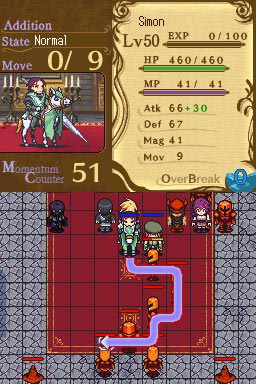What we have already played shapes our opinions of new games. To an SRPG fan, a game like Luminous Arc is old hat. Yet people new to the genre may be taken in by the musical score, voice acting, interesting story and quality breast-focused character art. Without knowing what has come before, the game seems competent enough and can provide some good strategic fun.
 |
|
|
The experienced SRPG fan likely sees Luminous Arc in a very different light. Its serviceable gameplay is often boring and it does very little to distinguish itself from older SRPGs beyond the innovative addition of painful load times between character turns. If you have played an SRPG or two in the past few years you will miss little by ignoring Luminous Arc. Of course if you are partial to the genre you may have already played the game and then realized the wallpaper images are the best thing to come from the design team.
Rondo of Swords would likely strike an SRPG novice as abstruse, masochistically difficult and ugly in both sight and sound. Very few would stick with the tedious, amateurish game. Characters look like they were drawn by your eight year old nephew, there are about three music tracks – also done by the same nephew – and the plot is never riveting or engrossing. Perhaps because it was written by a young relative of yours. Do you have any nephews?
It is the bizarre mechanics that will likely befuddle a newcomer as well as drive away the closed-minded SRPG enthusiast, but the peculiar design choices make the game worth playing. The most jarring change to the standard SRPG formula is in how units attack. Instead of attacking adjacent units after being positioned beside enemies, Rondo of Swords’s characters follow a path you map out for them and attack all enemies in their way.
Drawing an attack path through party members allows allies to grant boons unto the acting character such as increased HP, defense, attack, etc. This creates a strong motivation for clearly thinking out every move. This system also makes defending weaker party members very difficult as enemies can move through your characters the same you move through theirs. Simply blocking your healer with knights usually doesn’t work because right after attacking your knight, the enemy will proceed to mow down the healer.
There are mild wrinkles that give the system a little more depth, such as the Zone of Control feature and Momentum Counter. A character with ZoC stops oncoming attackers in their tracks, though a character with the skill to ignore ZoC ignores characters’ ZoC skill, conveniently enough. The Momentum Counter builds as your allies attack and use skills. As it increases your character may gain beneficial status effects but also stands out more on the field of battle. Manipulating the Momentum Counter works to a degree but often a weak unit with no momentum will be targeted regardless.
Getting used to these twists on the SRPG format takes considerable time, and the game is very difficult even after you’ve mastered attacking and unit placement. Riding through enemies is not such a crucial innovation that more SRPGs should adopt it but the system is fun and a refreshing change of pace considering nearly all SRPGs are either Fire Emblem (which begot Shining Force) or Final Fantasy Tactics (which begot Nippon Ichi games) clones.
 |
|
|
Rondo of Swords’s other attempts at adding something new to the genre are mostly failures but can be appreciated by the seasoned strategist. Gear shopping is done by choosing a character to buy or sell items instead of participating in the next battle. Unfortunately you will never know exactly what sort of items you can order characters to buy or sell because your options are limited to generic descriptions like “medals” and “HP items.” Even worse, your characters can sometimes fail entirely and not only return with no items but lose all the money you sent them to the store with. “I tripped and dropped the 5,000 gold you gave me.”
The quest system is similar to the shopping system in execution and dearth of explanatory information given to the player. Instead of fighting in the next mission, party members can be chosen to complete side quests but so little background is given for these that it’s almost impossible to pursue them without the help of a walkthrough.
Workable, possibly even enjoyable, systems are visible beneath the poorly executed shopping and questing mechanics. If there is a sequel, it is in these areas Success can most improve while still retaining Rondo of Swords’s defiance of SRPG norms. Instead of fleshing their ideas out this round Success seemed content to throw in some cameos from barely known game stars like Cotton (of shmups fame) and Izuna (of nearly pornographic Roguelike fame).
Which is a better game, Rondo of Swords or Luminous Arc? The former is certainly more interesting for the experienced SRPG gamer but both have qualities that make them appealing to different audiences. Just as a a hugely complex flight sim isn’t necessarily superior to a casual dog fighting game, there is no clear SRPG winner. But if you have put hundreds of hours into the genre and appreciate new ideas (even ones that don’t pan out) Rondo of Swords is a must play.

